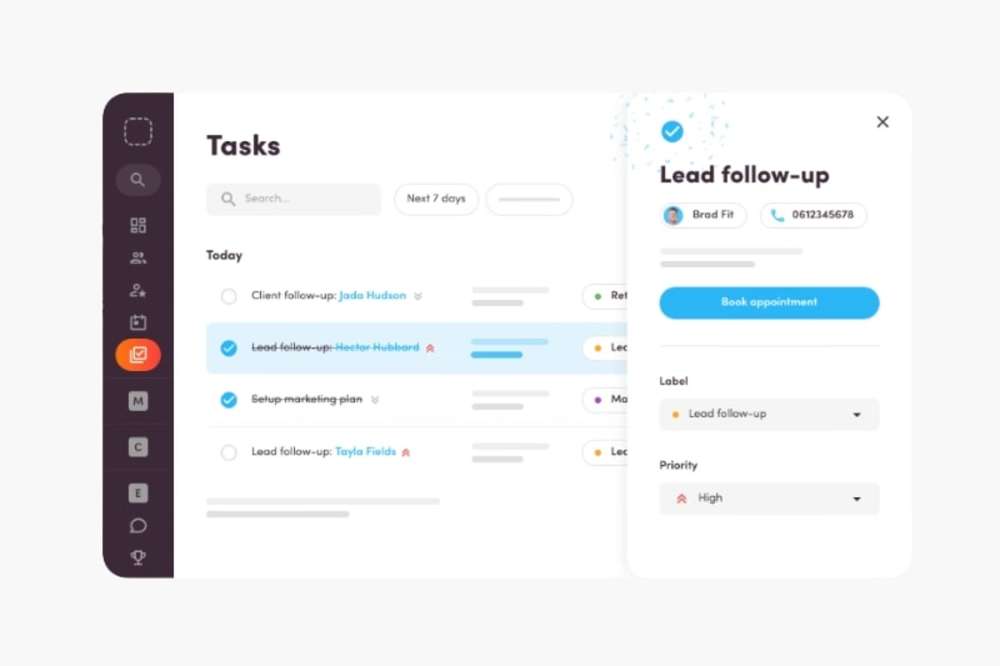Tired of trainers who disappear after three months and take your clients with them?
In the current health and fitness industry, people don’t sign up just for your equipment or your brand.
They come and stay with your people.
Your trainers are your business. They’re the reason clients show up, stay motivated, and renew their memberships.
So, when one leaves unexpectedly, it hits hard. You lose momentum, you lose trust, and worst of all, you might lose members too.
If this sounds familiar, you’re not alone. And more importantly, it’s not unsolvable.
This guide is here to help you fix the cycle.
Let’s build one you can count on.
Why You’re Struggling to Hire the Right Trainers

The fitness jobs hiring crisis isn’t just about finding bodies to fill positions; it’s about finding the right qualified professionals who will invest in your mission long-term.
Most gym owners fall into predictable traps that sabotage their personal trainer hiring success from the start. 😟
Lack of Specialization & Future Prospects
One overlooked reason trainers leave is that they don’t see a clear path for growth.
Many fitness professionals work part-time, struggle to specialize, and eventually switch industries because they can’t see a sustainable future.
Industry-wide, trainer turnover can reach as high as 80% annually, and much of it is driven by unclear career paths, low-income part-time roles, and limited opportunities to specialize and grow professionally.
Misalignment with Your Studio’s Mission
This creates friction from day one. When trainers don’t understand or believe in your core values, they become cultural misfits who undermine team cohesion.
They might be technically skilled, but they’ll clash with your approach to client care, team collaboration, or business philosophy.
Hiring on skills instead of mindset
This is perhaps the biggest mistake. Sure, certifications and experience matter, but they’re not predictors of loyalty or cultural fit.
A trainer with perfect form but a toxic attitude will damage your environment faster than you can say “burpee.”
Meanwhile, someone with less experience but genuine passion for your mission can be trained and developed into a cornerstone of your company.
No clear onboarding or culture
No onboarding culture leaves new hires feeling lost and disconnected. Without proper integration, even well-intentioned trainers struggle to understand their role in the bigger picture.
They operate in silos, never feeling like true team members, which makes leaving feel easy when better recruitment opportunities arise.
The 5 Qualities of Trainers Who Actually Stick Around

Mindset over muscle: shared values trump certifications every time.
The trainers who stay longest are those who genuinely believe in your approach to fitness and client care.
They see their role as more than just counting reps; they understand they’re part of a larger mission to transform lives.
These trainers naturally align with your organization’s practices because they share your fundamental beliefs about what fitness should accomplish.
Growth-minded: they want to learn, not just clock hours.
Trainers who stick around are hungry for development.
They ask questions, seek feedback, and view challenges as opportunities to improve.
They’re not satisfied with maintaining the status quo; they want to evolve their skills and contribute to your gym’s growth.
This growth mindset makes them essential to your long-term success.
Team players: they lift your culture, not just weights.
The best long-term trainers understand that success is collective. They celebrate wins, collaborate on client challenges, and contribute to a positive environment.
They don’t see colleagues as competition; they see them as partners in creating quality connections with clients and each other.
These trainers become culture carriers who help onboard new team members and maintain standards even when management isn’t around.
Reliable AF: they show up, take ownership, and do the work.
Consistency is non-negotiable in fitness. Trainers who last understand that their reliability directly impacts both client progress and gym operations.
They don’t just show up physically; they show up mentally prepared, emotionally present, and ready to give their best effort.
When problems arise, these are the kind of employees who take ownership and work toward solutions rather than making excuses.
People skills: they connect with clients, not just correct form.
Technical qualifications and knowledge are important, but the ability to build genuine relationships is what creates great jobs that clients rave about.
Personal trainers who excel at this understand that they’re not just movement coaches, they’re motivators, confidants, and sometimes the bright spot in someone’s difficult day.
These interpersonal skills make them invaluable to clients and difficult to replace.
Where (And How) to Find Fitness Trainers

The best trainers aren’t just scrolling job boards; they’re part of your talent search waiting to be discovered.
Go to local fitness schools and certification programs
Don’t just post a flyer on their board, get in front of students.
- Give a guest lecture once a quarter about real-world coaching, your studio’s mission, or client retention.
- Offer shadow days, let top students observe your sessions.
- Build a direct pipeline: “We’re always looking for passionate grads. Here’s how to apply.”
This simple partnership puts you ahead of other gyms fishing in the same talent pool.
Make your referrals easy and worth it
Passive word-of-mouth isn’t enough; structure it.
Offer a clear incentive: “Bring in a trainer we hire and keep for 90 days, and get a free month’s membership or €100 gift card.”
Remind members at the front desk, in your app, and in your newsletters. No one will refer if they don’t know it exists.
Equip your team with a simple script: “Hey, do you know anyone passionate about fitness who’d be a great trainer? We’re hiring and we reward referrals!
Make social media work for you, not just your members.
Posting sweaty selfies and team photos won’t cut it. Be intentional.
Here’s how to get results:
- Make your job posting super clear: Use a straightforward headline like “Fitness Trainer Job Posting in {Your Location}.” This helps you show up in local search and stops people from scrolling past.
- Create a simple lead campaign: Run Facebook or Instagram lead ads for your open roles. These work really well right now. Check the Facebook Ad Library for inspiration. Keep it short and on-brand.
- Use a quick, no-hassle questionnaire: Don’t scare people away with a long application. Ask for just the essentials:
- Name
- Education/background
- How many hours are they looking for, and why
- Email & phone number
That’s it! Remember, people are often scrolling while standing in line or on the go; the easier you make it to respond, the more leads you’ll get.
- Keep qualifications simple: Don’t cram a wall of text into your caption. Be clear, but not complicated, highlight what’s non-negotiable and what you can train on. Short, clear captions convert best.
An example of a personal trainer ad.
Now Hiring: Certified Personal Trainer in Chicago
Join our vibrant team and help clients achieve their fitness goals in a supportive, modern studio.
- Flexible hours: part-time or full-time
- Competitive hourly pay + bonuses
- Clients provided: no cold selling required
Requirements: Certification, friendly attitude, reliability.
To apply: Send your name, experience, availability, and contact details to [email].
Read our full guide on where to find the best personal trainers for your gym.
Red Flags to Avoid During Hiring

Below are some of the most common red flags that gym owners and studio managers in the fitness industry mention — and why ignoring them can cost you in the long run.
Vague answers about goals or availability
If a candidate struggles to explain their career goals or gives vague responses about when they can work, that’s a serious warning sign.
It often means they lack direction, aren’t serious about the role, or are keeping their options open.
Someone who can’t commit during an interview is unlikely to show up with consistency, reliability, or long-term dedication.
These are often the trainers who disappear after a few months, taking your clients with them.
“Just here for now” attitude
When someone openly admits they’re only doing this until they “figure things out” or “find something better,” take them at their word.
This mindset shows they’re not planning to grow with your team or build anything meaningful.
You’ll spend time onboarding and training them, only to have them leave the second a better opportunity comes along. It’s not just frustrating, it’s costly for your business.
Negative talk about past employers
It’s one thing to be honest about past challenges.
But when a candidate spends most of the interview complaining about old bosses, toxic coworkers, or gym policies with zero accountability, it’s a red flag.
This kind of person often brings the same issues into your workplace. They create drama, lower team morale, and can poison your gym culture from the inside.
Resistance to feedback
Trainers who react poorly to constructive criticism, whether it’s brushing it off, becoming defensive, or making constant excuses, rarely improve.
And in a client-facing role, this is especially risky.
They may ignore form corrections, argue with management, or even cause harm due to stubbornness.
A good trainer sees feedback as a tool. A bad one sees it as a threat.
Only chasing money or clout
It’s easy to spot the ones who are more interested in their personal brand than your gym’s mission.
These trainers often ask more about commission structures and Instagram visibility than about how they’ll help clients succeed.
They tend to hop from gym to gym, chasing higher pay or better “aesthetic” opportunities.
Loyalty, consistency, and client care aren’t their priorities, so don’t expect them to stick around.
Your Retention Strategy Starts Day One

Retention isn’t just about keeping your members — it’s also about keeping your team.
The moment someone walks through your door, whether they’re joining as a client or stepping in as a new coach, the clock starts ticking. ⏰
Have a clear onboarding plan
Don’t just tell new trainers what to do; help them understand why it matters. A structured onboarding plan should include more than facility tours and policy checklists.
Teach them your gym’s philosophy, client care standards, and what “success” looks like in your environment.
Make it clear how their role directly contributes to client results, team morale, and business growth.
Pair them with experienced mentors who can guide them through the first few months, answer questions, and model the kind of behavior you want replicated.
Communicate expectations, but also listen
Yes, it’s important to communicate your expectations clearly, but equally important is creating space for new trainers to share their thoughts, questions, and feedback.
If conversations are only top-down, you’ll get compliance, not engagement.
Schedule regular check-ins not just to evaluate progress, but to ask what they’re noticing, what’s working, and what they’re struggling with.
This kind of open dialogue makes them feel heard, respected, and more invested in their role.
Involve them in team culture, not just operations
Trainers who feel like outsiders won’t stay long.
From day one, include new hires in team meetings, group chats, staff events, and collaborative decisions when appropriate.
Invite them into the culture, not just the workflow.
When people feel like part of a mission-driven team rather than replaceable workers, they build emotional ties to the job, and those ties make them far less likely to walk away.
Offer growth opportunities (education, career paths)
If a trainer doesn’t see a clear path forward, they’ll eventually look elsewhere.
Offer growth opportunities like continuing education credits, leadership tracks, mentorship roles, or specialty certifications.
Help them deepen their skills, expand their role, or explore new directions within your business.
The message is simple: “We’re invested in your career, not just your current job.” That kind of long-term thinking builds long-term loyalty.
Give regular feedback + check-ins
Don’t wait for the annual performance review to speak up.
Regular, bite-sized feedback, both constructive and encouraging, can help trainers grow without feeling judged or blindsided.
Address issues early, before they become habits.
Celebrate progress, not just perfection. Recognizing effort, improvement, and alignment with values goes a long way in making trainers feel seen, supported, and motivated to keep improving.
Celebrate wins and loyalty
When a trainer goes above and beyond, hits a milestone, or sticks with you through a tough season, acknowledge it publicly and meaningfully.
Whether it’s a shoutout at a meeting, a post on social media, or a small gift with a handwritten note, recognition builds pride and belonging.
It also sets the tone for what’s valued in your gym culture and encourages others to follow suit.
💬 “Trainers leave when they feel invisible. Make them feel like a key part of your mission.”
Use the Right Staff Management Software in the fitness industry

Here’s how Virtuagym helps you keep your team organized and your studio running smoothly.
In the health and fitness industry, software like Virtuagym doesn’t just support your clients — it helps you manage your team. From scheduling and communication to hours tracking and onboarding, everything lives in one place.
That means fewer tools, fewer mistakes, and way more headspace to focus on what really matters: your members, your mission, and your team’s performance.
Staff Scheduling & Class Assignments

Easily assign trainers to group classes, personal training sessions, and specialty workshops in just a few clicks.
No more last-minute texts asking “Who’s covering the spinning classs tonight?” or awkward double bookings.
Everyone sees their schedule in real time, whether they’re on a desktop or using the mobile app. One tap, and everything’s clear, synced, and always up-to-date.
The system intelligently matches available staff to open slots based on their roles, skills, and preferred hours, reducing guesswork and manual juggling.
Task Management

Need someone to sanitize the studio, follow up with a lead, or post on Instagram? Create and assign internal tasks directly in the system.
Build structured workflows with checklists, due dates, and recurring to-dos so your team always knows what’s expected.
Best of all, you get full visibility into what’s been done and by whom, without having to micromanage anyone.
Think like a CEO, delegate with clarity, and track progress without constantly chasing updates.
The platform gives you visibility into what’s been done, by whom, and when, all with team consent, transparency, and accountability baked in.
Shift Planning & Availability

Coaches can set their availability, block off time for vacations or appointments, and even request shift swaps, with full visibility for you.
Additionally, it works for everyone: freelancers, part-timers, and full-time coaches alike.
The system respects staff preferences and only finalizes changes once everyone gives their consent, avoiding last-minute surprises.
No more endless back-and-forth messages. You’ll save hours every week just by letting the system handle the logistics.
Want to see how it works?
👉 Book a free Virtuagym demo and see the staff planner in action.
Conclusion: Build a Team You’re Proud Of

The right trainers won’t just stay, they’ll help you grow. They’ll become ambassadors for your brand, mentors for future hires, and partners in building something meaningful.
When you get this right, you’ll stop dreading the hiring process and start looking forward to expanding your team.
Your members deserve consistency, your business deserves stability, and you deserve a team you can count on.
The strategies in this guide will help you determine who’s in it for the long haul and who’s just passing through.




